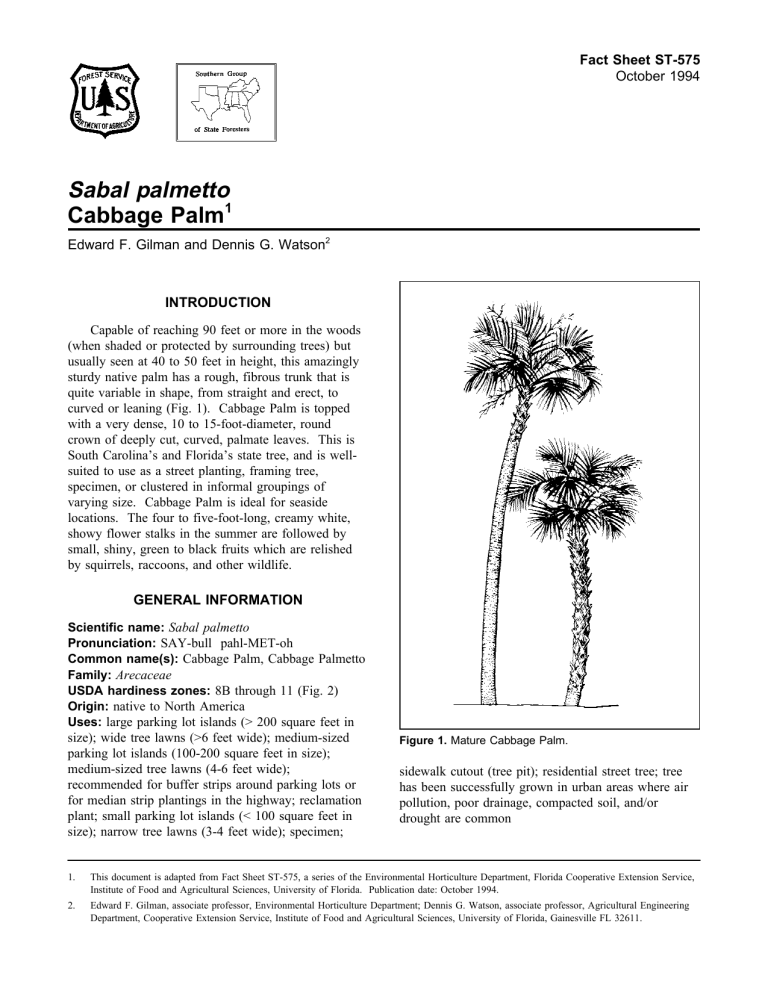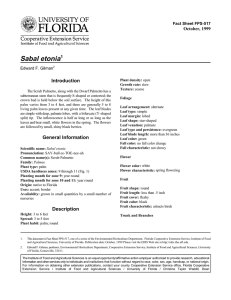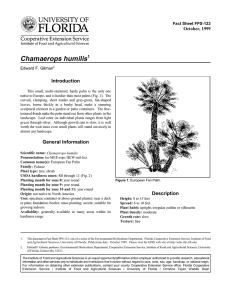Sabal palmetto Cabbage Palm Fact Sheet ST-575 1

Fact Sheet ST-575
October 1994
Sabal palmetto
Cabbage Palm
1
Edward F. Gilman and Dennis G. Watson
2
INTRODUCTION
Capable of reaching 90 feet or more in the woods
(when shaded or protected by surrounding trees) but usually seen at 40 to 50 feet in height, this amazingly sturdy native palm has a rough, fibrous trunk that is quite variable in shape, from straight and erect, to curved or leaning (Fig. 1). Cabbage Palm is topped with a very dense, 10 to 15-foot-diameter, round crown of deeply cut, curved, palmate leaves. This is
South Carolina’s and Florida’s state tree, and is wellsuited to use as a street planting, framing tree, specimen, or clustered in informal groupings of varying size. Cabbage Palm is ideal for seaside locations. The four to five-foot-long, creamy white, showy flower stalks in the summer are followed by small, shiny, green to black fruits which are relished by squirrels, raccoons, and other wildlife.
GENERAL INFORMATION
Scientific name: Sabal palmetto
Pronunciation: SAY-bull pahl-MET-oh
Common name(s): Cabbage Palm, Cabbage Palmetto
Family: Arecaceae
USDA hardiness zones: 8B through 11 (Fig. 2)
Origin: native to North America
Uses: large parking lot islands (> 200 square feet in size); wide tree lawns (>6 feet wide); medium-sized parking lot islands (100-200 square feet in size); medium-sized tree lawns (4-6 feet wide); recommended for buffer strips around parking lots or for median strip plantings in the highway; reclamation plant; small parking lot islands (< 100 square feet in size); narrow tree lawns (3-4 feet wide); specimen;
Figure 1. Mature Cabbage Palm.
sidewalk cutout (tree pit); residential street tree; tree has been successfully grown in urban areas where air pollution, poor drainage, compacted soil, and/or drought are common
1.
This document is adapted from Fact Sheet ST-575, a series of the Environmental Horticulture Department, Florida Cooperative Extension Service,
Institute of Food and Agricultural Sciences, University of Florida. Publication date: October 1994.
2.
Edward F. Gilman, associate professor, Environmental Horticulture Department; Dennis G. Watson, associate professor, Agricultural Engineering
Department, Cooperative Extension Service, Institute of Food and Agricultural Sciences, University of Florida, Gainesville FL 32611.
Sabal palmetto -- Cabbage Palm Page 2
Figure 2. Shaded area represents potential planting range.
Availability: generally available in many areas within its hardiness range
DESCRIPTION
Height: 40 to 50 feet
Spread: 10 to 15 feet
Crown uniformity: symmetrical canopy with a regular (or smooth) outline, and individuals have more or less identical crown forms
Crown shape: palm; upright
Crown density: open
Growth rate: slow
Texture: coarse
Foliage
Leaf arrangement: spiral
Leaf type: costapalmate
Leaf margin: entire
Leaf shape: orbiculate; star-shaped
Leaf venation: palmate
Leaf type and persistence: broadleaf evergreen; evergreen
Leaf blade length: >36 inches
Leaf color: green
Fall color: no fall color change
Fall characteristic: not showy
Flower
Flower color: white
Flower characteristics: showy; summer flowering
Fruit
Fruit shape: round
Fruit length: < .5 inch
Fruit covering: dry or hard
Fruit color: black
Fruit characteristics: attracts squirrels and other mammals; inconspicuous and not showy; fruit, twigs, or foliage cause significant litter
Trunk and Branches
Trunk/bark/branches: grow mostly upright and will not droop; not particularly showy; should be grown with a single leader; no thorns
Pruning requirement: needs little pruning to develop a strong structure
Breakage: resistant
Sabal palmetto -- Cabbage Palm
Crown shaft: no
Culture
Light requirement: tree grows in part shade/part sun; tree grows in full sun
Soil tolerances: clay; loam; sand; acidic; alkaline; extended flooding; well-drained
Drought tolerance: high
Aerosol salt tolerance: high
Soil salt tolerance: good
Other
Roots: surface roots are usually not a problem
Winter interest: no special winter interest
Outstanding tree: not particularly outstanding
Invasive potential: seeds itself into the landscape
Verticillium wilt susceptibility: not known to be susceptible
Pest resistance: long-term health usually not affected by pests
USE AND MANAGEMENT
Cabbage Palm is about as hurricane-proof as a tree can be. They stand after many hurricanes have blown over the oaks and snapped the pines in two. They adapt well to small cutouts in the sidewalk, and can even create shade if planted on 6 to 10 foot centers.
Clean the trunk of leaf bases to eliminate a habitat for roaches.
Cabbage Palm is exceptionally easy to transplant and will thrive in full sun or partial shade. It will adapt to slightly brackish water as well as dry, sandy locations and requires no special care once established.
But it needs to be watered regularly until established since all cut roots die back to the trunk after transplanting. New roots are regenerated from the base of the trunk and require warm soil temperatures and plenty of water to survive. There is evidence showing that removing all the fronds increases transplant survival. Tie the top-most fronds together if only lower fronds are removed so that the bud is protected during transport. Cabbage Palm is droughttolerant, but not until it is well-established in the landscape after transplanting. New transplants
(particularly those receiving too little water) are particularly susceptible to the palm weevil which kills the palm. Although one of the hardier palms, 11degrees F. killed about twenty-five percent of the
Cabbage Palms in 1983 in Baton Rouge.
Page 3
Cabbage Palms are generally collected from existing stands and are not grown in nurseries. Seeds germinate readily in the landscape, generating many seedlings. Removing the seedlings from beneath the canopy can be a nuisance.
Sabal peregrina, planted in Key West, grows to about 25 feet high. Sabal minor, a native Dwarf
Palmetto, creates an exotic, usually stemless shrub, four feet high and wide. Older Dwarf Palmettos develop trunks to six feet tall. Sabal mexicana grows in Texas and looks similar to Sabal Palmetto.
Pests
Giant palm weevil, cabbage palm caterpillar, and a large number of scales infest Cabbage Palm. The giant palm weevil attacks recently transplanted palms and can kill them.
Diseases
Ganoderma butt rot is perhaps the most serious disease of Cabbage Palms. It kills palms which it infects. The disease enters the trunk primarily through injuries on the lower trunk and roots. Avoid irrigating the trunk. There is no control for butt rot, only prevention. Remove infected palms as soon as possible.





